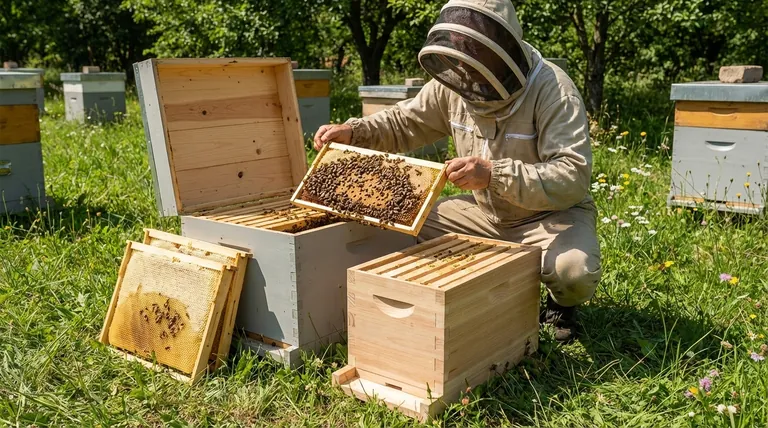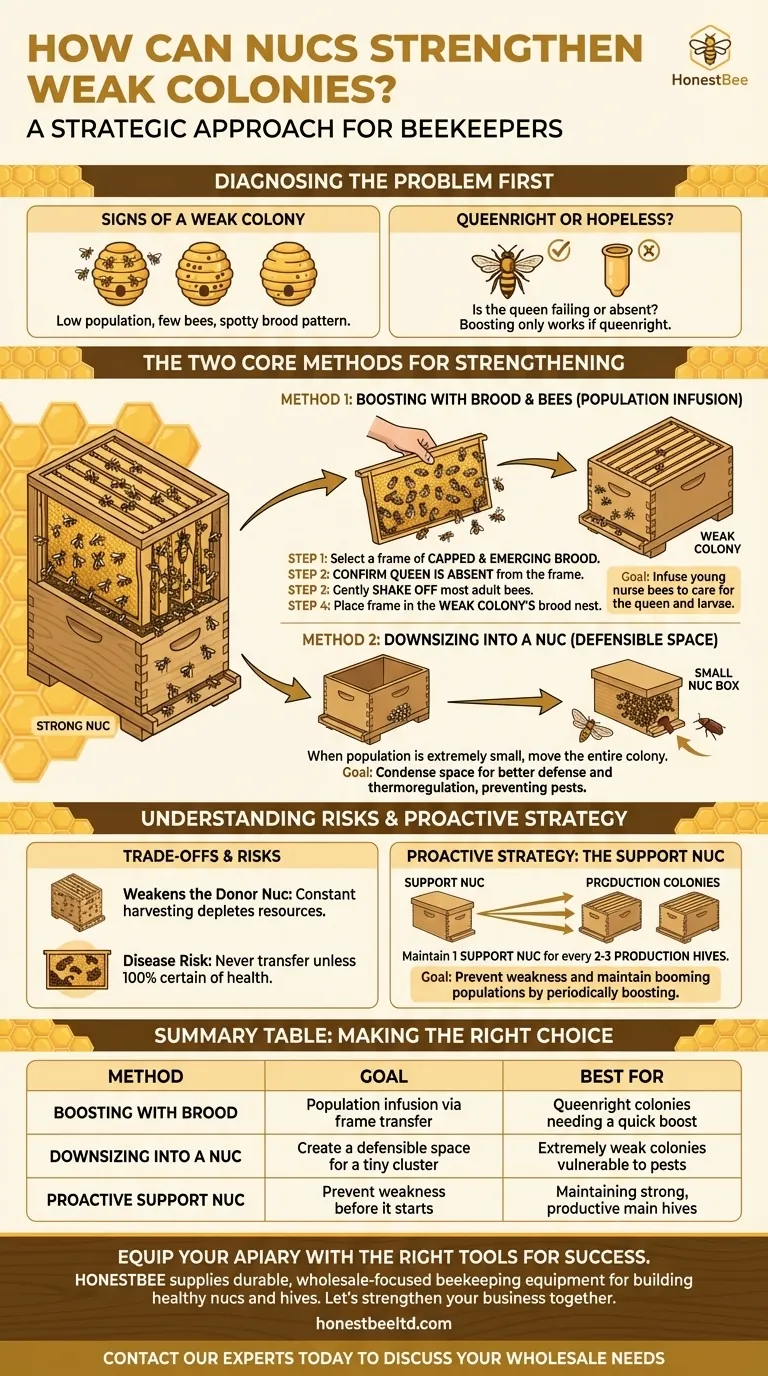Critically, a nucleus colony (nuc) serves two primary functions in strengthening a weak hive. You can either transfer resources—specifically frames of brood and bees—from the nuc into the weaker hive, or you can transfer the entire weak colony into a smaller nuc hive body to help it defend its space more effectively.
A nuc is not just a smaller hive; it is a strategic resource. Using one to strengthen a weak colony is a calculated transfer of population and resources to correct an imbalance and prevent a total colony collapse.

Diagnosing the Problem First
Before intervening, you must understand why a colony is weak. A population boost is only a temporary fix if the underlying issue, such as a failing queen or high mite load, is not addressed.
Signs of a Weak Colony
A weak colony typically has a low population of adult bees. You will see few bees on the outer frames and a small, often spotty, brood pattern. The colony may struggle to build up its population, even with ample nectar flow.
Queenright or Hopeless?
Adding resources is most effective for a queenright colony that has suffered a temporary setback, such as a poor spring buildup or minor pesticide exposure. If the colony is weak because the queen is failing or absent, adding brood will only delay the inevitable. The new bees will emerge, but without a productive queen, the colony has no long-term future.
The Two Core Methods for Strengthening
Once you've confirmed the weak colony has a viable queen, you can choose one of two methods depending on the severity of the weakness.
Method 1: Boosting with Brood and Bees
This is the most common method. You are essentially giving the weak colony a transfusion of new life to accelerate its growth.
The Goal: A Population Infusion
The aim is to add a frame of capped and emerging brood. As these new bees emerge over the next one to ten days, they will dramatically increase the hive's population of young nurse bees, who are critical for feeding larvae and caring for the queen.
The Transfer Process
- Select the Frame: From your healthy, strong nuc, choose a frame that is mostly covered with capped brood.
- Confirm the Queen is Absent: This is the most critical step. Carefully inspect the frame to ensure the nuc's queen is not on it. You do not want to accidentally transfer her.
- Shake the Bees (Optional but Recommended): Gently shake most of the adult bees from the brood frame back into the nuc. This minimizes the transfer of adult bees that might fight with the weak colony's population.
- Place the Frame: Position the new frame of brood in the center of the weak colony's brood nest, next to their existing brood. This helps the bees maintain a warm, contiguous area for raising young.
Method 2: Downsizing the Colony into a Nuc Box
If a colony's population has become extremely small, it cannot defend the large, open space of a full-size hive. This makes it a prime target for pests.
The Goal: A Defensible Space
Moving a tiny colony into a five-frame nuc box reduces the area they need to patrol and thermoregulate. This condensed space makes it far easier for the small population to guard the entrance and repel invaders like wax moths and small hive beetles.
The Benefits of a Smaller Home
In a smaller nuc box, the colony can concentrate its resources. Feeding is more efficient, and the bees can more easily maintain the crucial brood nest temperature. This gives the colony a fighting chance to rebuild its numbers in a protected environment.
Understanding the Trade-offs and Risks
Using a nuc as a resource is not without its costs. This is a strategic decision that involves balancing the health of multiple colonies.
Weakening the Donor Nuc
Every frame of brood you remove from a nuc weakens it. A strong nuc can typically spare a frame of brood every week or two, but constant harvesting will deplete its resources. This is why the concept of a dedicated "support nuc" is so important.
The Critical Risk of Disease
Never transfer frames from a nuc unless you are 100% certain it is healthy. Transferring a frame of brood is the fastest way to spread diseases like American Foulbrood or a high varroa mite load. Always inspect your donor nuc for signs of illness before taking any frames.
A Proactive Strategy: The Support Nuc
Instead of only reacting to weak hives, advanced beekeepers use nucs proactively to keep all colonies strong.
The Support Nuc Ratio
A good rule of thumb for hobbyists is to maintain one support nuc for every two to three production colonies. This ensures you always have resources on hand to boost a hive that is falling behind or to replace a failing queen.
Preventing Weakness Before It Starts
By periodically pulling a frame of brood from a support nuc and giving it to a production hive, you can maintain a booming population. This keeps your main colonies strong, improves honey production, and reduces the likelihood they will ever become weak enough to require an emergency rescue.
Making the Right Choice for Your Goal
- If your primary focus is to rescue a dwindling but queenright colony: Boost it by adding a single frame of capped, emerging brood from a healthy and strong nuc.
- If your primary focus is to save a tiny cluster from pests and exposure: Downsize the entire colony by moving its frames and bees into a smaller, more defensible nuc box.
- If your primary focus is to proactively manage hive strength and productivity: Maintain dedicated support nucs to constantly bolster your main hives, preventing them from becoming weak in the first place.
Using a nuc effectively transforms it from just a small colony into a powerful tool for managing the health and productivity of your entire apiary.
Summary Table:
| Method | Goal | Best For |
|---|---|---|
| Boosting with Brood | Population infusion via frame transfer | Queenright colonies needing a quick boost |
| Downsizing into a Nuc | Create a defensible space for a tiny cluster | Extremely weak colonies vulnerable to pests |
| Proactive Support Nuc | Prevent weakness before it starts | Maintaining strong, productive main hives |
Equip your apiary with the right tools for success. A strong beekeeping operation relies on quality equipment and smart management. HONESTBEE supplies commercial apiaries and beekeeping equipment distributors with the durable, wholesale-focused supplies needed to build and maintain healthy nucs and production hives. Let's strengthen your business together—contact our experts today to discuss your wholesale needs.
Visual Guide

Related Products
- 5 Frame Wooden Nuc Box for Beekeeping
- 5 Frame Langstroth Poly Nuc Corrugated Plastic Nuc Boxes
- HONESTBEE Professional Long Handled Hive Tool with Precision Cutting Blade
- HONESTBEE Professional Multi-Functional Hive Tool with Ergonomic Wood Handle
- HONESTBEE Advanced Ergonomic Stainless Steel Hive Tool for Beekeeping
People Also Ask
- How should the nuc be installed in the apiary? Ensure Colony Success from Day One
- What is the purpose of having a nuc in beekeeping? Build a Resilient & Productive Apiary
- What are the benefits of using nucs for beginning beekeepers? Ensure a Successful First Hive with a Head Start
- What are the benefits of starting a new bee colony in a nuc box? Boost Colony Success with Efficient Beekeeping
- What is the advantage of overwintering a nucleus? A Strategic Asset for Beekeeping Success



















